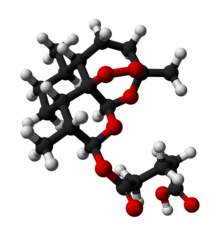 | |
 | |
| Clinical data | |
|---|---|
| Pronunciation | ahr-tez′ŭ-nāt[1] |
| Trade names | many[2] |
| Other names | SM-804 |
| AHFS/Drugs.com | Micromedex Detailed Consumer Information |
| License data |
|
| Routes of administration | By mouth, intravenous, intramuscular |
| Drug class | Artemisinin |
| ATC code | |
| Legal status | |
| Legal status | |
| Identifiers | |
| CAS Number |
|
| PubChem CID | |
| DrugBank |
|
| ChemSpider | |
| UNII |
|
| KEGG | |
| ChEBI | |
| ChEMBL |
|
| NIAID ChemDB | |
| PDB ligand | |
| CompTox Dashboard (EPA) | |
| ECHA InfoCard | 100.106.898 |
| Chemical and physical data | |
| Formula | C19H28O8 |
| Molar mass | 384.425 g·mol−1 |
| 3D model (JSmol) | |
| |
| |
| | |
Artesunate (AS) is a medication used to treat malaria.[3][5][6] The intravenous form is preferred to quinine for severe malaria.[5] Often it is used as part of combination therapy, such as artesunate plus mefloquine.[6] It is not used for the prevention of malaria.[6] Artesunate can be given by injection into a vein, injection into a muscle, by mouth, and by rectum.[6][7][8]
The most common side effects include kidney failure requiring dialysis, hemoglobinuria (the presence of hemoglobin in urine) and jaundice.[9]
Artesunate is generally well tolerated.[7] Side effects may include a slow heartbeat, allergic reaction, dizziness, and low white blood cell levels.[6] During pregnancy it appears to be a safer option, even though animal studies have found harm to the baby.[10] Use is likely fine during breastfeeding.[11] It is in the artemisinin class of medication.[5]
Artesunate was developed by Liu Xu in 1977.[12] It is on the World Health Organization's List of Essential Medicines.[13] It was approved for medical use in the United States in May 2020.[14] It is in the class of medications known as artemisinins, which are derivatives from "qinghao," or sweet wormwood plant (Artemisia annua).[15][5]
- ^ "Artesunate definition". Drugs.com. Archived from the original on 20 December 2016. Retrieved 7 December 2016.
- ^ "Artesunate". Drugs.com. Archived from the original on 20 December 2016. Retrieved 7 December 2016.
- ^ a b "Artesunate for injection safely and effectively. See full prescribing information for Artesunate for injection. Artesunate for injection, for intravenous use Initial U.S. Approval: 2020". DailyMed. 5 November 2021. Retrieved 11 March 2022.
- ^ "Artesunate Amivas EPAR". European Medicines Agency. 28 February 2020. Retrieved 27 June 2024.
- ^ a b c d "Intravenous Artesunate for Treatment of Severe Malaria in the United States". U.S. Centers for Disease Control and Prevention (CDC). Archived from the original on 29 October 2016. Retrieved 28 October 2016.
- ^ a b c d e "Artesunate" (PDF). World Health Organization. March 2013. Archived from the original (PDF) on 28 December 2013. Retrieved 7 December 2016.
- ^ a b Rosenthal PJ (April 2008). "Artesunate for the treatment of severe falciparum malaria". The New England Journal of Medicine. 358 (17): 1829–1836. doi:10.1056/NEJMct0709050. PMID 18434652. S2CID 8480109.
- ^ World Health Organization (October 2018). Rectal artesunate for pre-referral treatment of severe malaria. Global Malaria Programme (Report). World Health Organization. hdl:10665/259356. WHO/HTM/GMP/2017.19; License: CC BY-NC-SA 3.0 IGO.
- ^ Cite error: The named reference
FDA snapshotwas invoked but never defined (see the help page). - ^ Kovacs SD, Rijken MJ, Stergachis A (February 2015). "Treating severe malaria in pregnancy: a review of the evidence". Drug Safety. 38 (2): 165–181. doi:10.1007/s40264-014-0261-9. PMC 4328128. PMID 25556421.
- ^ "Artesunate use while Breastfeeding | Drugs.com". www.drugs.com. Archived from the original on 20 December 2016. Retrieved 7 December 2016.
- ^ Li G, Li Y, Li Z, Zeng M (28 November 2017). Artemisinin-Based and Other Antimalarials: Detailed Account of Studies by Chinese Scientists Who Discovered and Developed Them. Academic Press. ISBN 9780128132111.
- ^ World Health Organization (2019). World Health Organization model list of essential medicines: 21st list 2019. Geneva: World Health Organization. hdl:10665/325771. WHO/MVP/EMP/IAU/2019.06. License: CC BY-NC-SA 3.0 IGO.
- ^ Cite error: The named reference
FDA PRwas invoked but never defined (see the help page). - ^
 This article incorporates text from this source, which is in the public domain: Centers for Disease Control and Prevention (August 2007). "Notice to Readers: New Medication for Severe Malaria Available Under an Investigational New Drug Protocol" (PDF). MMWR Morb. Mortal. Wkly. Rep. 56 (30): 769–70.
This article incorporates text from this source, which is in the public domain: Centers for Disease Control and Prevention (August 2007). "Notice to Readers: New Medication for Severe Malaria Available Under an Investigational New Drug Protocol" (PDF). MMWR Morb. Mortal. Wkly. Rep. 56 (30): 769–70.